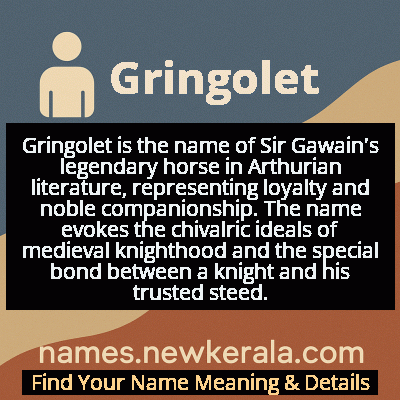Gringolet Name Meaning & Details
Origin, Popularity, Numerology Analysis & Name Meaning of Gringolet
Discover the origin, meaning, and cultural significance of the name GRINGOLET. Delve into its historical roots and explore the lasting impact it has had on communities and traditions.
Name
Gringolet
Gender
Male
Origin
Arthurian
Lucky Number
8
Meaning of the Name - Gringolet
Gringolet is the name of Sir Gawain's legendary horse in Arthurian literature, representing loyalty and noble companionship. The name evokes the chivalric ideals of medieval knighthood and the special bond between a knight and his trusted steed.
Gringolet - Complete Numerology Analysis
Your Numerology Number
Based on Pythagorean Numerology System
Ruling Planet
Saturn
Positive Nature
Ambitious, efficient, realistic, and authoritative.
Negative Traits
Materialistic, stressed, confrontational, and can be overly ambitious.
Lucky Colours
Dark blue, black.
Lucky Days
Saturday.
Lucky Stones
Blue sapphire, amethyst.
Harmony Numbers
2, 4, 6.
Best Suited Professions
Business leaders, managers, financial services, law enforcement.
What People Like About You
Leadership, determination, organizational skills.
Famous People Named Gringolet
Gringolet (Literary)
Legendary War Horse
Faithful steed to Sir Gawain in numerous Arthurian romances
Gringolet (Equestrian)
Tournament Champion
Carried Gawain to victory in countless jousts and quests
Gringolet (Symbolic)
Literary Archetype
Established the template for the noble knight's companion
Name Variations & International Equivalents
Click on blue names to explore their detailed meanings. Gray names with will be available soon.
Cultural & Historical Significance
Extended Personality Analysis
Gringolet is characterized by exceptional loyalty, courage, and reliability—traits that made him the ideal companion for Gawain's numerous adventures. Medieval texts consistently portray him as intelligent and responsive, capable of understanding his rider's intentions and adapting to challenging situations. His bravery in battle is matched by his endurance during long journeys, making him the perfect embodiment of chivalric virtues in equine form. The horse's personality reflects a balance of wild strength and disciplined training, suggesting an animal that maintains its essential nature while serving nobly alongside his human partner. This combination of traits made Gringolet not just a mount but a character who contributed significantly to Gawain's successes, representing the medieval ideal of the perfect war horse—fierce when needed, gentle when appropriate, and always dependable.
Modern Usage & Popularity
Today, Gringolet remains primarily within the realm of Arthurian scholarship and enthusiast communities, with virtually no usage as a contemporary given name. Its appearances are largely confined to academic discussions of medieval literature, historical reenactment groups, and occasional references in fantasy genre works. The name's strong association with a specific literary character and its archaic sound prevent widespread modern adoption, though it occasionally surfaces in the naming of horses among owners with Arthurian interests or in medieval-themed entertainment. Its usage patterns reflect a name preserved in amber—maintaining its original character and associations without evolving into modern naming conventions, thus serving as a pure example of literary onomastics from the Arthurian tradition.
Symbolic & Spiritual Meanings
Symbolically, Gringolet represents the essential partnership between knight and steed that defined medieval chivalric ideals. He embodies the physical strength and endurance required for questing, while also symbolizing the loyalty and trust necessary for true companionship. Metaphorically, the horse serves as a bridge between the civilized world of Arthur's court and the wild, unpredictable landscapes through which knights journeyed. Gringolet's consistent presence across Gawain's adventures suggests he represents not just a means of transportation but an extension of the knight's own virtues—the animal strength and instinct that complements human reason and morality. In broader terms, he symbolizes how true achievement often depends on reliable partnerships and how nobility can manifest in non-human forms, reflecting medieval beliefs about the hierarchical yet interconnected nature of creation.

